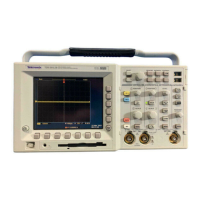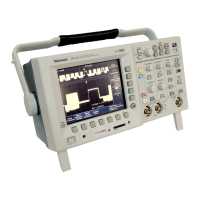Getting Started
Measurement Features
Cursors. You can use cursors to take simple voltage, time, and
frequency measurements. (See page 70.)
Automatic Measurements. Yo u can choose from a list of automatic
waveform measurements. (See page 99.) You can customize the
measurements by changing reference levels or by adding measurement
gating. (See page 9 6.)
XY Waveform Cursors. You can use cursors to take measurements on XY
waveforms. (See pag e 74.)
Trigger Features
Dual Tr
iggers.
You can use the main (A ) trigger system alone or add the
B trigger to capture more complex events. You can also use the A and
B triggers together to set up a wait-for-time or wait-for-events tr igger.
(See p
age 111.)
Logic Triggers. You can trigger on a Boolean condition between two
signals. You can use logic triggers to analyze problems in digital
circuits, or synchronous state machines. (See page 117.)
Pulse Triggers. You can trigger on a signal that meets a timing or
threshold condition. You can use pulse triggers to analyze problems in
digital ci rcu its, with bu s contention, or in b us transceivers, transmission
lines, and op-amp circuits. (See pa ge 1 23.)
Video T rigger. Yo u can trigger on video fields or lines to see a stable
display of s tand ard video signals. (See page 131.)
Alternating Trigger. You can sequentially use each active channel as
a trigger sou rce, from th e lowest-n umbered active channel to the
highest-numbered active channel. (See page 115.)
Built-In External Trigge r. All models have an external trigger input.
Four-channel models have th e external trigger connecto r on the back
of the oscilloscope. Two-channel models have th e external trigger
connector on the front panel.
TDS3000C Series O scilloscope User Manual 7
